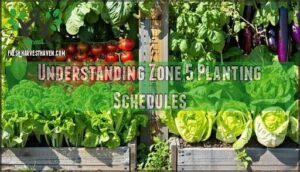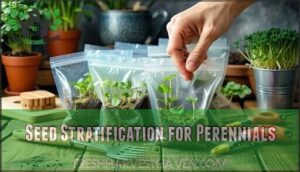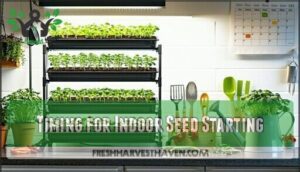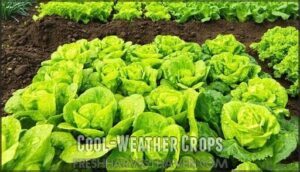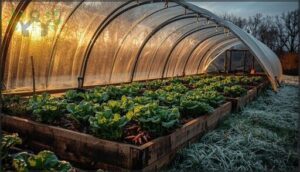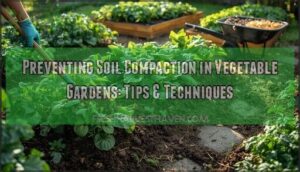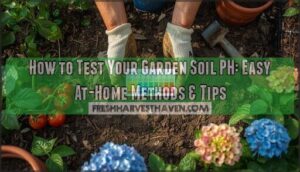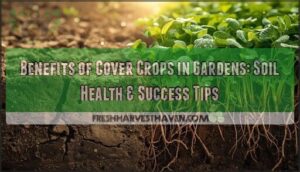This site is supported by our readers. We may earn a commission, at no cost to you, if you purchase through links.
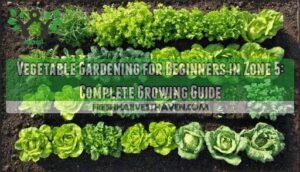
You’ll want to start cool-season crops like lettuce, spinach, and peas directly in the garden 2-4 weeks before that final frost. Meanwhile, get warm-season favorites like tomatoes and peppers started indoors 6-8 weeks earlier.
Zone 5’s shorter growing season means timing is everything, but don’t let that intimidate you.
Perennials like asparagus and rhubarb are your garden’s workhorses, returning year after year without replanting. The key is working with your climate, not against it.
Smart planning and a few season-extending tricks can transform your zone 5 plot into a surprisingly productive space.
Table Of Contents
- Key Takeaways
- Preparing for Zone 5 Gardening
- Understanding Zone 5 Planting Schedules
- Indoor Seed Starting Techniques
- Planting Vegetables in Zone 5
- Choosing Ideal Vegetables for Zone 5
- Fruits and Additional Crops for Zone 5
- Managing Pests and Diseases in Zone 5
- Harvesting and Storing Zone 5 Crops
- Extending The Growing Season in Zone 5
- Frequently Asked Questions (FAQs)
- Can you plant vegetables in Zone 5?
- When should you plant a garden in Zone 5?
- Which plants grow well in Zone 5?
- What climate zone do vegetables grow in?
- When should I plant a tomato plant in Zone 5?
- Does lettuce grow in Zone 5?
- When to plant a vegetable garden in zone 5?
- What is the easiest vegetable to grow for a beginner?
- What is the best size vegetable garden for a beginner?
- When to start tomato plants in zone 5?
- Conclusion
Key Takeaways
- Master your frost dates – You’ll need to know your last spring frost (typically mid-to-late May) to time cool-season crops like lettuce 2-4 weeks before and warm-season plants like tomatoes after the danger passes.
- Start seeds indoors for maximum success – Begin tomatoes and peppers indoors 6-8 weeks before your last frost date to get a crucial head start on zone 5’s short 140-160 day growing season.
- Choose varieties that work with your climate – Focus on fast-maturing varieties (60-70 days) and cold-hardy crops like kale, spinach, and peas that actually improve in flavor after light frosts.
- Extend your season with simple techniques – Use succession planting every 2-3 weeks, cold frames for winter growing, and row covers for frost protection to maximize your harvest window beyond the basic growing season.
Preparing for Zone 5 Gardening
Getting your zone 5 garden ready means understanding your frost dates and planning ahead.
You’ll typically face your last spring frost around May 30th, giving you about 140-160 growing days to work with.
Smart garden planning starts with knowing your microclimate, preparing your soil, and scheduling your planting schedules around these critical dates.
Understanding Zone 5 Planting Schedules
Zone 5’s 140-160 day growing season demands precise timing. Your frost dates become the backbone of successful vegetable gardening for beginners – typically mid-May through early October.
However, microclimate impact creates pockets where temperatures vary by weeks within your own yard. Frost date variations aren’t just weather predictions – they’re your planting roadmap. That sunny south wall might allow April plantings while shaded areas wait until June.
Smart zone 5 gardening means tracking these patterns year after year. Your planting schedules should maximize every frost-free day.
- Start succession planting cool crops every 2-3 weeks for continuous harvests
- Choose fast-maturing varieties (60-70 days) to beat fall frosts
- Establish perennial vegetables like asparagus for long-term yields
- Map microclimates to stagger plantings across different garden zones
The best vegetables zone 5 are those that work with your shortened timeline, not against it. Consider selecting proper seeds for quicker harvests.
Indoor Seed Starting Techniques
Starting seeds indoors gives you a six-to-eight-week head start on the growing season, which is essential when you’re working with Zone 5’s shorter frost-free period.
You’ll want to set up your seed-starting operation about six weeks before your last expected frost date, typically around mid-April for most Zone 5 areas.
Seed Stratification for Perennials
Perennial plants operate like nature’s time locks—they won’t germinate until they’ve experienced winter’s chill. Stratification benefits include breaking seed dormancy and improving germination rates for your zone 5 gardening projects.
Nature’s patience pays off—cold treatment unlocks seeds that refuse to wake up otherwise.
Mix seeds with moist peat moss, seal in plastic bags, and refrigerate for 2-4 weeks. This cold requirements process mimics natural winter conditions.
For maximum convenience, consider using readily available seed stratification bags.
Monitor moisture levels carefully—too wet causes rot, too dry fails stratification. Proper seed viability depends on consistent temperature and humidity during this seed starting phase for perennial plants.
Pre-Sprouting for Corn and Beans
Pre-sprouting transforms your beginner vegetable garden by giving corn and beans the perfect head start they crave. This technique delivers Faster Germination and enhanced Seedling Vigor while providing essential Weather Flexibility for zone 5 gardening challenges.
Here’s your step-by-step process:
- Place seeds between damp paper towels in a warm spot
- Check daily for emerging white roots (typically 3-5 days)
- Plant immediately once roots appear to prevent Root Damage
- Enjoy Reduced Labor compared to traditional seed starting methods
This approach guarantees successful seed germination when spring soil remains too cool for direct sowing. A specialized sprouting system can further simplify this process.
Timing for Indoor Seed Starting
While pre-sprouting gives corn and beans a head start, your seed starting timeline matters just as much for other crops.
Start most seeds indoors 6-8 weeks before your last frost date – typically May 15th in zone 5. This frost date countdown prevents weak, leggy plants from starting too early while avoiding transplant shock from late starts.
Consider the best time to start based on the plant type.
Transplant timing varies by crop: tomatoes need starting March 4-18, peppers in mid-February, and herbs around March 18.
Your grow light duration should provide 12-16 hours daily, positioned 2-3 inches above seedlings. Keep germination temperatures between 65-75°F for strong development.
Begin your hardening off schedule one week before planting outdoors. Gradually expose seedlings to outdoor conditions – think of it as plant boot camp.
This planting schedule approach guarantees your vegetable gardening for beginners efforts pay off with healthy transplants ready for zone 5 gardening success.
Planting Vegetables in Zone 5
You’ll need to watch the calendar and soil temperature, since planting in Zone 5 is all about timing and frost dates.
If you’ve ever tried to outsmart a late spring frost, you know it’s smart to plan your cool-weather and frost-tender crops by month for the best harvest.
Cool-Weather Crops
Four essential cool-weather crops will transform your zone 5 gardening success by tolerating frost and thriving in chilly conditions.
These hardy vegetables handle soil temperatures down to 40°F and actually develop sweeter flavors after light frost hits your garden.
Plant these frost-tolerant champions 2-4 weeks before your last frost date, typically in early April. Their bolting prevention comes naturally in cool weather, while succession planting every two weeks extends your harvest window through summer.
Remember that successful gardening in Zone 5 requires awareness of the approximate last frost around May 1st.
Your coolweather crops for zone 5 gardening include:
- Spinach – matures in 30 days, perfect for beating frost dates
- Kale – develops complex sweetness after frost exposure
- Lettuce – provides continuous harvests with proper variety selection
- Peas – climb supports while enriching soil naturally
These vegetables thrive when soil temperature stays between 45-65°F. Start with hardy varieties that match your local planting schedules, and you’ll enjoy fresh harvests while warm-season crops are still just seeds indoors.
Frost-Tender Seedlings
Unlike their hardy counterparts, frost-tender seedlings demand your protective instincts and careful timing in zone 5 gardening. These delicate plants—tomatoes, peppers, cucumbers, and squash—can’t handle temperatures below 36°F without serious damage.
Seedling Hardening is your secret weapon for success. Start this process 7-10 days before transplanting by gradually exposing indoor-grown plants to outdoor conditions. Begin with 2-3 hours of filtered sunlight, then increase exposure daily until they’re spending full days outside.
Frost Protection becomes critical when unexpected cold snaps threaten your investment. Row covers, cloches, or even old bedsheets can save tender plants from devastating frost damage.
Wait until soil temperature reaches 60°F and your last frost date passes before transplanting these sensitive plants for vegetable gardening success.
Planting Schedules by Month
Timing your zone 5 gardening correctly turns nervous beginners into confident growers.
Your planting schedules must follow nature’s rhythm while adapting to local frost dates.
Here’s your monthly zone 5 planting guide:
- March: Start hardy seedlings indoors like cabbage and broccoli for early transplants
- April Planting: Direct sow peas, spinach, lettuce, and radishes when soil becomes workable
- May Planting: Plant beans, corn, and squash after final frost danger passes completely
- June Planting: Transplant tomatoes, peppers, and heat-loving vegetables safely outdoors
- Fall Planting: Sow winter crops like kale, carrots, and turnips for extended harvests
Track your area’s specific frost dates yearly and adjust these schedules based on experience for better success.
Gardeners should also consider soil temperature importance for ideal growth.
Choosing Ideal Vegetables for Zone 5
Selecting the right vegetables for your Zone 5 garden sets you up for success throughout the growing season.
Focus on varieties that can handle your shorter frost-free period and cooler temperatures while still producing abundant harvests.
Asparagus and Beets
Building successful zone 5 gardening starts with choosing reliable crops like asparagus and beets.
Asparagus crowns establish perennial harvests lasting decades when planted in well-prepared soil.
Beet varieties provide dual harvests—roots and nutritious greens—making them perfect for vegetable gardening for beginners.
Soil preparation requires pH between 6.0-7.0 for ideal growth.
Companion planting with onions maximizes space efficiency while deterring pests naturally.
Harvesting tips: Cut asparagus spears when pencil-thick, harvest beet greens early for tender leaves.
Broccoli and Brussels Sprouts
These broccoli-and-Brussels-sprouts champions deserve prime real estate in your zone 5 gardening adventure. Both cold climate gardening favorites handle frost better than you handle Monday mornings.
Broccoli varieties like ‘Belstar’ resist clubroot disease, while ‘Green Magic’ matures quickly. Planting spacing matters—give broccoli 12-18 inches and Brussels sprouts 24 inches to breathe. Soil requirements include pH 6.0-6.8 and consistent moisture.
Here’s what awaits your vegetable gardening for beginners efforts:
- Tight broccoli heads glistening with morning dew
- Brussels sprouts lined like green pearls on sturdy stalks
- Fresh side shoots emerging after cutting main heads
- Frost-kissed Brussels sprouts with candy-sweet flavor
- Companion dill attracting beneficial insects for Brussels sprout pests control
Start seeds indoors 6-8 weeks before last frost. Plant dill nearby—it’s like hiring bodyguards for your crops. Harvesting timing is vital: cut broccoli before flowers open and Brussels sprouts after light frost for peak sweetness.
Cabbage and Kale
Cabbage and kale shine as zone 5’s most dependable leafy vegetables.
Choose hardy cabbage varieties like ‘Copenhagen Market’ for reliable heads that withstand frost. Kale benefits include continuous harvests from spring through winter with proper protection.
Growing tips for success:
- Plant early – Start seeds indoors 6-8 weeks before last frost
- Practice companion planting – Pair with herbs like dill for natural pest control
- Use row covers – Protect from cabbage moths and flea beetles
- Harvest strategically – Cut outer kale leaves while inner ones keep growing
Carrots and Cauliflower
These two vegetables offer the perfect partnership for your zone 5 gardening adventure.
Carrot varieties like Nantes and Chantenay deliver sweet, crisp roots that beginners can grow with confidence.
Meanwhile, cauliflower types such as Snowball and Purple Top thrive in your cool spring weather.
Companion planting works like magic here—carrots naturally loosen compacted soil while cauliflower’s shallow roots appreciate the improved drainage.
You’ll want to protect both crops with row covers during their vulnerable seedling stage for effective pest prevention.
Master your harvest timing by pulling carrots when they’re finger-thick for maximum sweetness.
Cut cauliflower heads before the curds start separating—that’s your window for peak flavor.
Consistent watering and loose, well-draining soil create the foundation for success with both vegetables.
Planting Time
Harvest Window
Common Issues
Fruits and Additional Crops for Zone 5
While vegetables might be your main focus, adding fruits and other crops will round out your Zone 5 garden beautifully.
These additions provide variety to your harvest and help you make the most of your growing space throughout the season, which can include complete concepts like crop rotation and companion planting.
Apples and Berries
Expanding your zone 5 gardening beyond vegetables means choosing the right apple cultivars and berry varieties for reliable harvests. Honeycrisp and Pink Lady apples produce consistently in your climate, while Gravenstein offers excellent cold hardiness.
You’ll need at least two different apple varieties for proper pollination since most aren’t self-fertile. Berry varieties like red raspberries (Nova, Encore) and blueberries (Northsky, Patriot) handle your winter temperatures beautifully.
Remember that blueberries need acidic soil with pH 4.5-5.5, while apples prefer 6.0-7.0.
Your fruit tree care routine should include these pruning techniques:
- Remove old raspberry canes after harvest, keeping 3-4 young canes per foot
- Prune blueberry bushes in late winter before buds break
- Cut diseased apple branches immediately to prevent spread
- Maintain proper spacing – 20-30 feet for standard apple trees.
Winter protection starts with mulching around trees and removing fallen fruit to reduce pest problems. These perennials reward your planting schedules with decades of fresh fruit.
Potatoes and Radishes
After you’ve picked your favorite berries, it’s time to get your hands dirty with potatoes and radishes—two easy vegetables to grow that really shine in Zone 5 gardening.
For potatoes, choose reliable potato varieties like Yukon Gold or Red Norland.
Plant certified seed potatoes 4 inches deep in loose, well-drained soil once the ground hits 45°F.
Give each tuber 12 inches of elbow room.
A little patience pays off—harvest after 70-90 days, then cure and stash them in a cool, dark spot.
Radishes are the speedsters of the vegetable garden.
Sow seeds about half an inch deep, with radish spacing at 3-5 cm apart.
They’re ready in as little as 25-30 days.
Use companion planting to tuck radishes alongside slower crops.
For pest control, rotate crops and keep soil loose.
Pull radishes when marble-sized for best flavor.
Rhubarb and Spinach
Rhubarb varieties like Victoria and Canada Red bring perennial magic to your zone 5 gardening adventure. These hardy plants return each spring without replanting, making vegetable gardening simpler once established.
Plant crowns in early spring when soil workable, but resist the urge to harvest for two years—patience pays off with robust stalks.
Rhubarb thrives in well-drained soil with morning sun and afternoon shade. Companion planting works well with strawberries and beans, which won’t compete for space or nutrients.
Spinach loves cool weather and grows fast in zone 5. Sow seeds in March or late August for best results.
Growing conditions include rich, moist soil and partial shade during hot spells. Spinach nutrients pack iron, vitamins A and K into every leaf.
Harvesting tips: Pull outer rhubarb stalks when finger-thick, twist and pull spinach outer leaves regularly. Both crops reward consistent picking with continued production throughout your planting schedules.
Managing Pests and Diseases in Zone 5
Even the healthiest Zone 5 gardens face challenges from pests like flea beetles, squash bugs, and Colorado potato beetles that can quickly damage your crops.
You’ll need to identify these common threats early and use proven organic methods like floating row covers, hand-picking, and companion planting to protect your vegetables without harmful chemicals, utilizing techniques such as companion planting.
Common Pests in Zone 5
Garden pest control in zone 5 can feel like a never-ending game of hide and seek. You’ll run into Flea Beetles, Squash Bugs, Cabbage Moth caterpillars, Potato Beetle, and Bean Beetles.
Zone 5 gardening means battling beetles, bugs, and moths that love your crops as much as you do.
These troublemakers chew leaves, suck sap, and spread disease, making pest control and disease prevention a must. Early detection is key—look for tiny holes, yellowing, or sticky leaves.
Integrated pest management keeps things in check. Try these tips:
- Hand-pick bugs and eggs early in the morning
- Use floating row covers to block pests
- Rotate crops to disrupt pest life cycles
Preventative Measures for Diseases
Protecting your crops from disease requires a proactive approach that starts before you even plant. Disease prevention beats treatment every time in zone 5 gardening.
Start with soil health—test pH levels and improve drainage since waterlogged soil invites trouble. Choose resistant varieties when shopping for seeds, as they’re your first line of defense. Practice crop rotation annually to disrupt disease cycles that overwinter in soil.
Proper watering practices matter tremendously. Water at soil level, not on leaves, and do it early morning so plants dry quickly. Air circulation prevents fungal problems, so space plants according to package directions and prune overcrowded areas.
| Prevention Method | How It Works |
|---|---|
| Crop rotation | Breaks disease cycles in soil |
| Resistant varieties | Natural genetic defense |
| Proper spacing | Improves air circulation |
| Soil-level watering | Keeps foliage dry |
| Clean tools | Prevents pathogen spread |
Clean your tools between plants and remove diseased material immediately—don’t compost it.
Organic Pest Control Methods
While disease prevention sets the foundation for healthy plants, you’ll still need effective organic strategies when pests inevitably show up in your zone 5 garden.
Think of beneficial insects as your garden’s free security system. Ladybugs, lacewings, and parasitic wasps work around the clock, devouring aphids and caterpillars before they can damage your crops. You can attract these helpers by planting diverse flowers and avoiding harsh chemicals.
Companion planting creates natural pest barriers that actually work. Marigolds repel nematodes around tomatoes, while basil planted near peppers confuses pest insects with its strong scent. This approach supports soil health and crop rotation principles simultaneously.
When prevention isn’t enough, these organic sprays deliver results:
- Neem oil disrupts pest life cycles without harming beneficial insects
- Insecticidal soap eliminates soft-bodied pests like aphids on contact
- Diatomaceous earth creates physical barriers against crawling insects
- Beer traps attract slugs and snails away from your vegetables.
Row covers provide temporary protection during vulnerable seedling stages. This organic vegetable gardening approach maintains natural balance while keeping your pest control efforts both effective and environmentally sound for long-term disease prevention success.
Harvesting and Storing Zone 5 Crops
Harvesting your Zone 5 vegetables at the right time guarantees peak flavor and maximizes your storage potential through the shorter growing season.
You’ll need to master proper storage techniques and seed-saving methods to make the most of your hard-earned harvest.
Timing for Harvesting Vegetables
Master the art of harvesting vegetables by watching for peak ripeness signals.
Tomatoes show full color, carrots resist gentle pulls, and leafy greens feel crisp.
Morning harvests yield better flavor before heat stress hits.
Your zone 5 gardening frost dates create predictable windows.
Staggered planting enables continuous harvest throughout the season.
Root vegetables actually sweeten after light frosts.
Frost monitoring helps time final harvests perfectly.
These natural indicators guide proper timing for your vegetable garden planning success.
Techniques for Storing Fruits and Vegetables
Your hard work in the garden paid off—now let’s turn that harvest into winter gold.
Root cellaring keeps potatoes, carrots, and beets fresh for months when stored in damp sand at 32-40°F. Canning methods and freezing produce preserve peak flavors, while dehydrating foods creates compact snacks. Fermentation techniques transform cabbage into sauerkraut and cucumbers into pickles.
Smart storage separates ethylene producers like apples from sensitive vegetables.
Pack root crops in perforated bags with damp sawdust to maintain moisture levels.
Your zone 5 gardening success continues through these food preservation victories:
- Taste summer’s sweetness in January’s frozen corn
- Share homemade pickles that remind friends of grandma’s kitchen
- Sleep peacefully knowing your pantry’s stocked with nature’s bounty
Saving Seeds From Favorite Plants
After properly storing your zone 5 harvest, you’ll want to save seeds from your best-performing plants. This practice builds genetic diversity while cutting costs for next season’s vegetable garden planning.
Choose open-pollinated varieties over hybrids for seed saving success. Hybrids won’t produce true-to-type offspring, making your efforts worthless. Collect seeds when they’re fully mature and completely dry – wet seeds rot quickly in storage.
Test seed viability before your next growing season begins. Place sample seeds between damp paper towels for a few days. If most sprout, you’ve got winners for harvesting vegetables next year. To maintain freshness, consider storage conditions that promote preservation.
Here’s your seed saving game plan:
- Store seeds in labeled envelopes inside airtight containers with silica gel packets
- Keep containers in cool, dark locations like refrigerators or basements
- Separate varieties by distance during growing to prevent cross-pollination risks
Follow seed saving laws in your area – some regions restrict certain varieties. These storage techniques guarantee your favorites return stronger each season, making zone 5 gardening more rewarding and cost-effective for seed starting adventures ahead.
Extending The Growing Season in Zone 5
Zone 5’s short growing season doesn’t have to limit your harvest when you master season extension techniques.
You can squeeze extra weeks or even months from your garden using cold frames, succession planting, and strategic timing adjustments.
Using Greenhouses and Cold Frames
After properly storing your Zone 5 harvest, greenhouses and cold frames reveal winter gardening possibilities you never imagined.
These structures create protective microclimates that extend your growing season well beyond October’s first frost.
| Structure Type | Temperature Regulation | Best Crops |
|---|---|---|
| Unheated greenhouse | Adds 20-30°F protection | Lettuce, spinach, kale |
| Heated greenhouse | Maintains 50-60°F | Tomatoes, peppers, herbs |
| Cold frame | Adds 10-15°F protection | Carrots, radishes, arugula |
| Mini hoop tunnel | Adds 5-10°F protection | Swiss chard, mache |
| Row covers | Adds 2-5°F protection | Late cabbage, turnips |
Structure materials range from budget-friendly recycled windows for cold frames to polycarbonate panels for serious zone 5 gardening enthusiasts.
Extending harvest becomes reality when you’re picking fresh greens in December.
A simple cold frame can add weeks to your harvest.
Your vegetable garden planning transforms from seasonal thinking to year-round abundance through smart microclimate creation.
Succession Planting Techniques
Why wait for one big harvest when you can enjoy fresh vegetables all season? Succession planting transforms your zone 5 garden into a continuous producer.
Here’s your step-by-step approach:
- Staggered Planting lettuce every 2 weeks for continuous harvest
- Variety Selection with different maturity dates maximizes space
- Crop Rotation prevents soil depletion between plantings
- Planting Schedules aligned with zone 5 gardening frost dates
- Maximizing Yield through strategic vegetable garden planning
This extending growing season technique keeps your table full.
Utilizing Grow Lights for Indoor Seed Starting
Growing your own seedlings gives you a head start on zone 5 gardening’s short season.
Grow lights turn any indoor space into a productive nursery, letting you control exactly what your plants need.
Your success depends on getting the basics right.
Light spectrum matters most – full-spectrum LEDs give seedlings the balanced wavelengths they crave.
Set your timer settings for 12-16 hours daily to mimic long summer days.
Seedling distance should stay 2-4 inches above plants, adjusting as they grow taller.
Choose the right fixture types for your space.
LED panels beat old fluorescent tubes every time, offering better energy efficiency and longer life.
You’ll slash electricity costs while boosting results.
Starting seeds indoors with grow lights means stronger transplants
- Watch tiny seeds transform into robust seedlings under your care
- Feel proud knowing you’re beating nature’s timeline
- Enjoy the satisfaction of nurturing life during winter’s darkest days
- Experience the thrill of earlier harvests than your neighbors
- Create a cozy indoor garden sanctuary that lifts your spirits
Adjusting Planting Schedules for Personal Experience
While grow lights jumpstart your indoor seeds, true zone 5 vegetable gardening success comes from fine-tuning planting schedules based on your yard’s unique personality.
Your garden has its own microclimate impact that standard frost dates can’t capture.
Start garden journaling to track when frost actually hits different spots, soil temperature readings, and which varieties perform best.
Note how your north-facing beds stay cooler longer, or how that sunny south wall creates a microclimate that extends your season.
This data helps you adjust planting schedules for maximum harvest.
| Garden Factor | Your Observations |
|---|---|
| First/Last Frost Dates | Record actual dates vs. predicted |
| Soil Temperature Timing | Track when soil reaches planting temps |
| Variety Selection Results | Note which cultivars thrive vs. struggle |
Local pests and frost tolerance vary even within neighborhoods.
Document which crops handle your specific conditions, then adjust timing accordingly for better yields.
Frequently Asked Questions (FAQs)
Can you plant vegetables in Zone 5?
You can definitely plant vegetables in Zone 5! Plant cool-season crops like lettuce and peas in April, then warm-season vegetables like tomatoes and peppers after mid-May’s last frost date.
When should you plant a garden in Zone 5?
You’ll want to start cool-season crops like peas and lettuce in April.
Then wait until mid to late May—after the last frost—to plant warm-season veggies.
Always check your local frost dates; weather loves surprises!
Which plants grow well in Zone 5?
Cool-season crops like lettuce, peas, kale, and spinach thrive in your Zone 5 garden, along with hardy vegetables such as broccoli, carrots, and cabbage that handle those chilly spring mornings.
What climate zone do vegetables grow in?
Vegetables thrive in various climate zones, from cool Zone 3 to warm Zone You’ll find success matching crops to your specific zone’s temperature ranges and frost dates for ideal growth.
When should I plant a tomato plant in Zone 5?
Apparently, Mother Nature didn’t get the memo about your gardening timeline! Plant tomatoes after your last frost date, typically mid-to-late May in Zone 5, when soil’s consistently warm.
Does lettuce grow in Zone 5?
Lettuce thrives in Zone 5’s cool climate. You can plant it in early April, weeks before the last frost. Choose cold-hardy varieties and enjoy multiple harvests through fall.
When to plant a vegetable garden in zone 5?
Dancing around Jack Frost’s schedule, you’ll plant cool-season crops like lettuce and peas in April, then warm-season vegetables like tomatoes after mid-to-late May’s last frost date.
What is the easiest vegetable to grow for a beginner?
Radishes are your best bet for beginners.
They’re virtually foolproof, sprouting in just days and ready to harvest in 30 days.
Plant them directly in soil, water regularly, and you’ll have success guaranteed.
What is the best size vegetable garden for a beginner?
Sarah’s first 4×4-foot garden overwhelmed her with weeds and neglect.
Start with a manageable 4×8-foot plot—that’s roughly 32 square feet.
You’ll easily maintain it, learn basics without stress, and grow enough vegetables for meaningful harvests while building confidence.
When to start tomato plants in zone 5?
Start tomato seeds indoors 6-8 weeks before your last frost date, typically around early April. You’ll transplant them outside after mid-May when nighttime temperatures stay above 50°F consistently.
Conclusion
Like a master gardener cultivating patience through seasons of trial and triumph, you’ve now gathered the essential tools for vegetable gardening for beginners in zone 5.
Your journey from frost-date novice to harvest-savvy grower doesn’t end here—it’s just beginning.
You’ll discover that each season teaches new lessons, from timing your first pea plantings to perfecting your tomato transplants.
Remember, even experienced gardeners started exactly where you’re now, armed with enthusiasm and basic knowledge, trust the process, embrace the learning curve, and celebrate every successful harvest along the way.
- https://minimalistbaker.com/how-to-make-kale-chips/
- https://www.almanac.com/gardening/frostdates
- https://homelyhens.com/garden/start-seeds-indoors-in-zone-5/
- https://grow.edenbrothers.com/learn-how-to-plant/how-to-start-a-garden/hardiness-zones-explained/gardening-in-zone-5/
- https://www.gurneys.com/collections/vegetables-zone5

